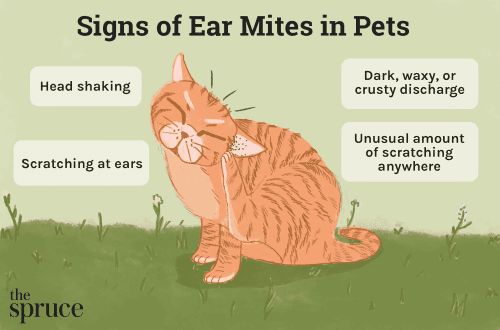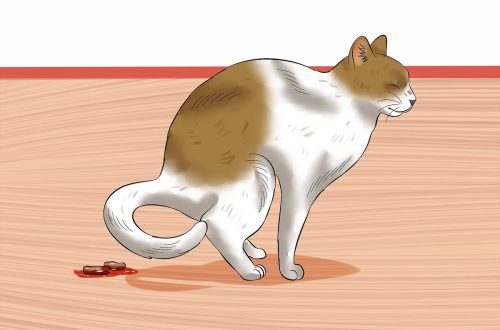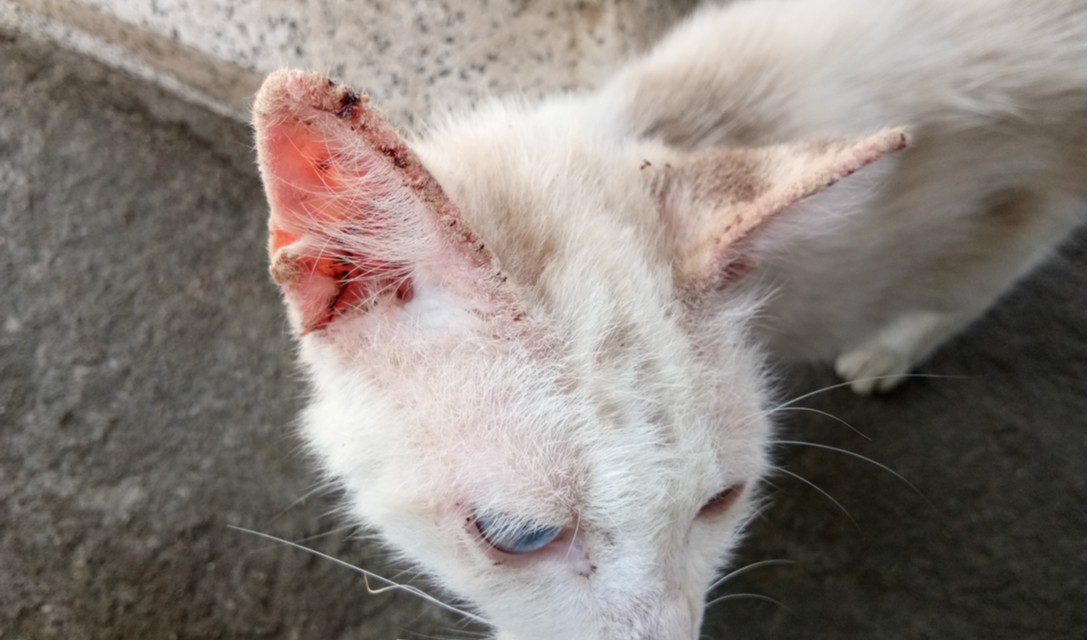
Scabies in cats

Contents
Scabies in Cats: Essentials
Scabies in cats is caused by tiny parasitic mites;
Signs of scabies are severe itching, scratching on the body, scales and crusts in the head and ears;
The main method of infection is contact, that is, when a healthy cat communicates with an infected one;
If you consult a doctor at the first signs of malaise, then the treatment will not present great difficulties.
Causes of scabies
When the scabies mite gets on the skin of a cat, it begins to gnaw its moves in the upper layers of the skin at a speed of two to three millimeters per day. First of all, fertilized females do this in order to lay eggs in the passages. After a while, the eggs turn into larvae. This larva also begins to dig its own passages, but towards the very surface of the skin. There she feeds and develops to an adult. Female and male ticks mate and the process is repeated. All these movements of ticks on the skin cause a very strong itch in the animal, the cat is able to itch day and night, forgetting about sleep and food.
In this case, a different amount of time can pass from the moment of the first infection to the onset of the onset of clinical symptoms. It usually ranges from several days to several weeks. It will depend both on the number of ticks that got on the cat initially, and on the immune response. It is believed that severe itching is also caused by the waste products of ticks by the type of an allergic reaction. Accordingly, if the body has previously had experience with this tick, then the allergy will develop faster and itching will appear earlier.
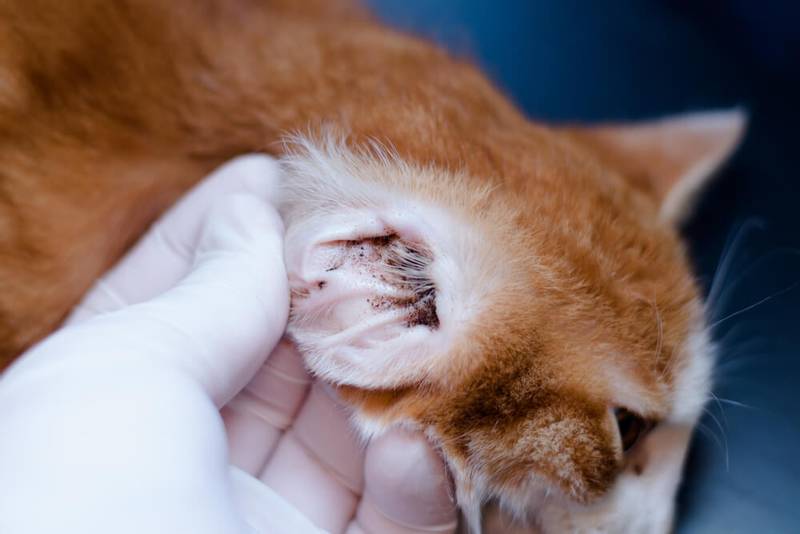
Otodectes (otodectes cynotis)
This mite infects the skin of the external auditory canal in an animal. It occurs in cats quite often and is very quickly transmitted between them. Its dimensions reach 0,3-0,5 mm. The tick feeds on lymph, tissue fluid and skin particles. During bites, the tick severely injures and irritates the skin. He also has a rather rough body and moves very actively, which also causes a sensation of itching and burning in the cat. This mite is a common parasite for many animal species. For a short time, the tick is able to live outside a living organism, that is, it can also be brought into your home on clothes and shoes.
Demodicosis (demodex cati and demodex gatoi)
Demodex cati and Demodex gatoi are two different pathogens, it would seem, of the same disease (demodecosis), however, depending on the type of parasite, the course will be completely different.
Demodex cati is a normal inhabitant of the cat’s skin. Its shape is elongated, cigar-shaped, dimensions are about 0,2-0,3 mm. Habitat – hair follicle. In the study of deep scrapings of the skin of healthy cats, it can be detected up to 100% of cases. It gets on the skin of the animal in the first 2-3 days of life from the mother during breastfeeding. However, clinical signs of the disease appear only with increased tick reproduction. This happens against the background of a decrease in the body’s immunity. Various diseases can be predisposing factors: hypothyroidism, oncology, diabetes mellitus, severe viral diseases. Demodicosis occurs in cats quite rarely and most often only due to iatrogenic causes, that is, taking immunosuppressive (immune suppressing) drugs.
Demodex gatoi is another representative of this disease. It, unlike the previous one, is not found on the skin of healthy cats, is transmitted by contact and always causes clinical symptoms. Its body is shorter, and its dimensions are even smaller – only 0,1-0,2 mm. It is also extremely rare in cats, the main symptom is severe itching. The main difficulty in making a diagnosis is that even with multiple deep scrapings, it can not be detected.
Cheyletiella yasguri
Heiletiella is a mite that lives in the superficial layers of the skin. On the skin and coat, parasites of light yellow or white color can be found, the size is small (0,25-0,5 mm). The parasite itself cannot be seen with the naked eye, but a large amount of dandruff on the skin can be noted, the second name for this disease is “wandering dandruff”. Ticks feed on skin particles, lymph and other fluids, and during a bite they can cause itching in an animal. Infection occurs mainly from sick animals. In the environment, the tick is not able to reproduce, but can live up to 2 weeks under favorable conditions.
Notoedros (notoedres cati)
These mites live in the upper layers of the skin – the epidermis. They are light yellow or white in color, have the smallest dimensions, from 0,14 to 0,45 mm. They mainly affect domestic cats and other felines, in rare cases, ticks can be found in dogs and rabbits. They feed on inflammatory fluid, lymph, epidermal cells. Notoedrosis is a very contagious disease, you can get sick without even having direct contact with an infected animal. Indoors, ticks live up to six days. If the environment has high humidity and average air temperature (10-15 ° C), they can live under such conditions for up to three weeks. Actually, notoedrosis is called scabies in cats, so we will analyze this ailment in more detail.

Photo of scabies in cats
Symptoms
Young animals are more prone to the development of feline scabies. Older cats may also develop symptoms, but much less frequently.
Clinical symptoms are typical for this disease, so it is not difficult to make a preliminary diagnosis: any practicing doctor knows what scabies looks like in cats. Notoedrosis typically affects areas of the body such as the cat’s head and ears. At the very beginning of the disease, peeling and crusts can be noted on the lower part of the ears closer to the head. Over time, the lesions spread and go up the ears. Then they move to the muzzle area, affect the eye area, chin, neck. If treatment is not started at this stage, the disease will spread further through the body, to the limbs, perineum. In especially neglected cases, the entire body of the animal is affected, the skin becomes rough, dense skin folds with large gray crusts become visible, and hair falls out.
Also, a characteristic symptom will be active itching, the cat will tear the affected areas with its paws, lick intensively. That is why notoedrosis is popularly called cat scabies. Due to severe itching, the animal may feel unwell, refuse to eat, and not sleep. Without treatment, a secondary bacterial infection joins, lymph nodes may enlarge, vomiting will appear, severe lethargy. Ultimately, the cat will die from sepsis.
Infection methods
The main route of infection is contact. Outside the host, the tick is able to live for a very short time, all processes of nutrition, growth and reproduction occur only in the skin of the animal. However, notoedres cati is highly contagious between cats. If someone in a group of animals has this disease, with a high degree of probability, all of them will soon become infected. In the environment, the tick can live up to a week and still remain infectious. That is, even cats that live only in an apartment without access to the street have a small chance of becoming infected with a tick, which the owners brought from a walk on clothes or shoes.
Since the body’s own immunity also plays a role in the development of clinical symptoms, it is quite rare to see notoedrosis in street cats. However, these cats can be latent carriers, meaning they don’t get sick themselves, but they can infect others, such as your house cats.
Diagnostics
A preliminary diagnosis can be made after the initial examination of lesions characteristic of notoedrosis. These include scales and crusts on the muzzle and ears, as well as scratching due to severe itching. The diagnosis can be confirmed with the help of scrapings and their microscopic examination. The detection of even one live tick is enough to make a diagnosis, although most often quite a lot of them are found, you can see several individuals in one field of view of the microscope. In rare cases, it is not possible to find ticks in scrapings, then a trial treatment may be offered. In the presence of positive dynamics in response to treatment, the diagnosis can also be considered confirmed.
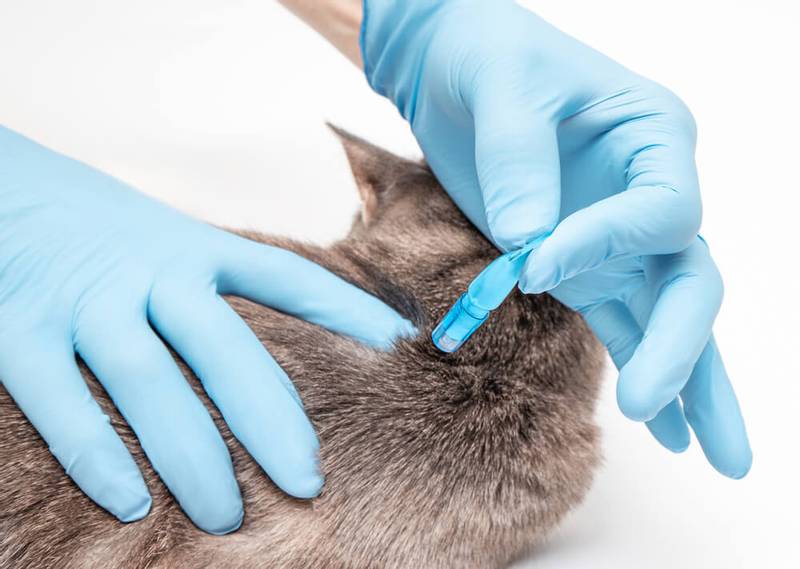
Treatment of scabies in cats
How and how to treat scabies in a cat is determined by the attending physician individually in each case. When contacting a doctor in the early stages of the disease, treatment does not cause difficulties. The main modern medicines for scabies in cats include drugs from the group of isoxazolines (fluralaner) and the group of macrocyclic lactones (selamectin, moxidectin). Such drugs are produced in the form of drops at the withers, they are very simple and easy to use, and most importantly, they have a minimal list of contraindications and side effects. It is worth applying them to the skin in the withers area so that the cat cannot reach out and lick it off.
Scabies in kittens
Scabies in a kitten will not be fundamentally different from that in an adult animal. They are more susceptible to this disease because of the not yet formed immunity. Also, they are more likely to have combined invasions: for example, notoedrosis, otodectosis and cheyletielosis can be detected at the same time.
Prevention
The best preventive measure is the regular use of antiparasitic drugs, in cats these are usually drops on the withers. If you pick up a stray cat on the street, you need to take it to the doctor before bringing it home. If there are already cats at home, it is recommended to isolate them from the new resident for a period of quarantine, observation and, if necessary, treatment. Usually, domestic cats are left with their usual rooms, and a separate small room is allocated to a new pet.
Can a person get infected?
Notoedrosis can be transmitted to humans and cause “pseudo-scabies”. This is a condition in which a person may experience itching, visible lesions on the skin, pimples, scratching of the hands and body. At the same time, the tick cannot multiply in human skin and, accordingly, does not gnaw through the passages there. The reaction of a person is associated only with an allergy to the waste products of the tick, so treatment is not required and everything goes away after the pet is cured.
The article is not a call to action!
For a more detailed study of the problem, we recommend contacting a specialist.
Ask the vet
February 16 2021
Updated: 21 May 2022




